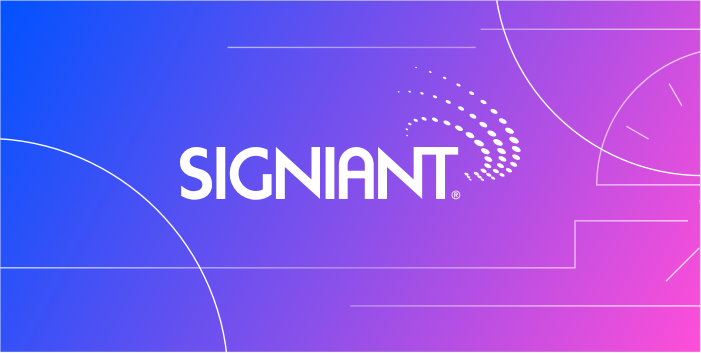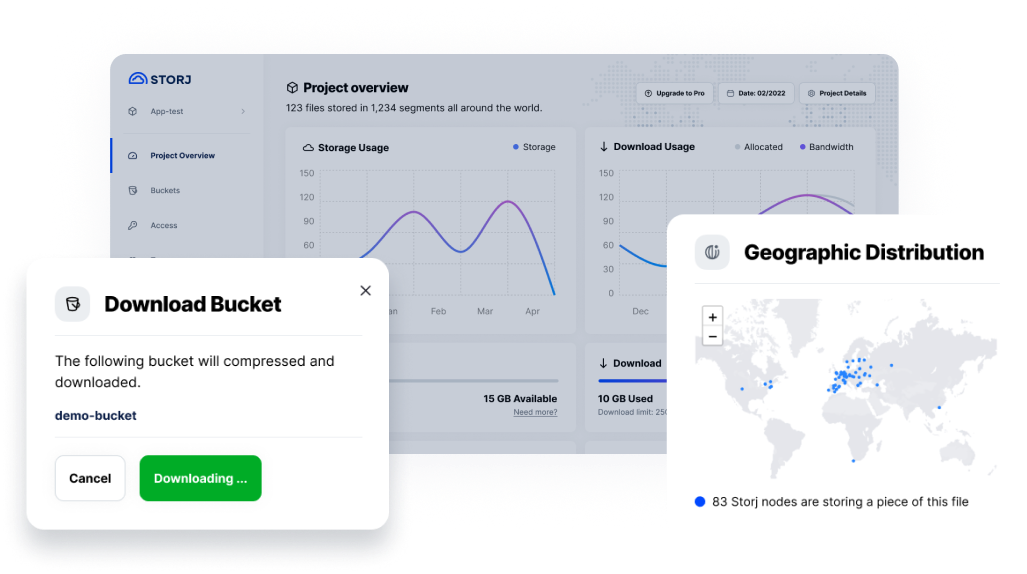
Replicating large datasets across regional data centers is costly. There are added costs for replicating the files, storing them, and for egress. Basically, it is a multiplier on storage costs whenever you want to provide access to your data in a new region. There is also additional development cost for configuring this model.
All in, this makes it very costly for customers of traditional data center providers like AWS, Wasabi, or Backblaze to expand globally. But what if you could eliminate regional replication without hurting performance?
You can with Storj distributed cloud storage.
This article explains how the unique architecture of Storj’s globally distributed storage network delivers excellent performance to anywhere in the world—especially for large files. And it does this without making copies and storing them in regional data centers.
Globally distributed storage eliminates multi region storage
Storj has a distributed network of nodes to store and retrieve data, instead of centralized servers. This means that the data is broken up and stored across tens of thousands of devices in more than 100 countries. Parallelism is used on download and data from the fastest nodes are used to reconstitute the file requested.

This allows for improved performance and lower latency when accessing data, as data can be retrieved from a node that is geographically closer to the user. By leveraging the power of a globally distributed network, Storj can provide fast and reliable access to download large datasets from anywhere in the world.
This eliminates the need for multi-region storage as data is already stored globally across the network. Users can access the data from anywhere in the world with low latency, without having to rely on replicated data stored in multiple regions.
This simplifies the tech stack from having to configure for replication and significantly reduces costs that would normally have to be spent on multi-region storage and egress for data replication.
But is it as fast as using regional data centers?
Storj has extremely consistent performance that is as good as data centers and better the further you move away from the data center. How do we know? We tested it.

When compared to S3 single-region storage, Storj has more consistent throughput because it pulls from many nodes simultaneously, drastically increasing the probability of uncongested paths. S3 performance is affected by intermittent internet slowdowns. This is especially true when the S3 origin is far away from the download location.
We also looked at real-world results from 301,859 sampled download events of customers who opted in to telemetry. The distributions of traffic across a variety of file sizes, usage patterns, end user networks and other environmental variables were quantized every 1000 km from Portland, OR. Customers see consistent performance independent of distance.
How does Storj accomplish this?
- Uses less bandwidth - Erasure codes have a lower expansion factor than replication but have high durability. They reduce required data transmission.
- Avoids long-tail variance - Uploading and downloading from excess nodes lets us care only about the fastest nodes in any set, turning variance into a strength.
- Minimizes coordination - Metadata storage is in a simple federated model, instead of coordination-heavy globally shared ledgers or similar.
- Maximizes parallelism - The internet is big and we get to use all of it by taking the fastest data from the fastest nodes to reconstitute the file requested.
The combination of these factors yields consistent performance anywhere in the world.
Is this SOC 2 compliant?
It can be that, and much more. Storj has a feature called Storj Select that enables companies to store their data wherever they want and nowhere they don’t want. To accomplish this Storj has the capability for customers to configure groups of nodes for storage of data at the account, project or bucket level. This means that Storj Select can accommodate use cases such as:
- Storing objects in data centers with security certifications such as SOC 2
- Restricting the selection of nodes to particular geographic regions
- Storing objects in a way that can deliver specific performance characteristics
Whether you need compliance with data protection regulations or have particular requirements for a multi-cloud strategy or user performance, Storj gives you the flexibility to easily select and configure your storage groups.
(Read more about our Storj Select and our Compliance offerings.)
So what’s the catch?
There isn't one. In fact, Storj is simpler to secure and lower cost than cloud storage hyperscalers like AWS. And compared to budget cloud providers like Wasabi and Backblaze, Storj is still significantly less expensive (especially with recent price hikes) and out performs them in speed, security, availability, and durability. Storj is the only cloud storage provider that offers end-to-end encryption of data and metadata by default. And Storj has never lost a file and has 11 nines of availability.
As to cost, not only are you eliminating the added costs of data replication and multi-region storage, Storj is also 80%-90% less expensive than AWS. To put it in perspective, storage on AWS S3 is $23 per TB and $80 per TB for egress. On Storj, you’ll pay $4 per TB for storage and $7 per TB for egress. For anyone distributing large media assets, that is a big cost savings. See this short video for a more in-depth explanation of how regional replication costs add up.
Want to get a personalized comparison of Storj costs versus Wasabi and Backblaze? You can use this simple calculator to compare your monthly bill.










